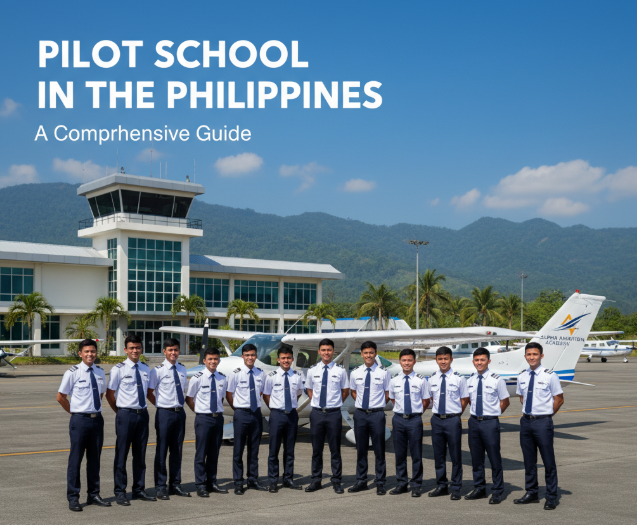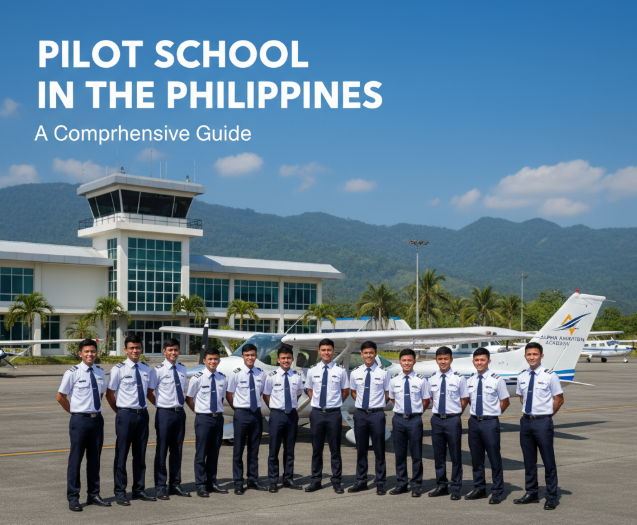
Introduction to Pilot School in Philippines
Aviation has long been an essential sector in the Philippines, playing a vital role in the country’s economic development and international connectivity. As a gateway to various regions in Southeast Asia, the Philippines is home to a robust aviation industry, which in turn fuels the growth of pilot schools and flight training programs. This blog explores the essential components of pilot training in the Philippines, from its history to modern-day offerings, and the future of aviation in the country.
Pilot training in the Philippines is structured around a series of specialized courses that aim to create skilled professionals capable of working in both commercial and defense aviation sectors. This guide will cover everything you need to know about pilot schools, the training process, and career prospects in the aviation field in the Philippines.
What is Pilot Training?
Pilot training refers to the systematic education and practical instruction provided to aspiring aviators, including basic flying lessons, theoretical coursework, and specialized training to handle specific types of aircraft. This process is designed to ensure that individuals meet the required standards set by national and international aviation authorities for safe and proficient flying.
Different Types of Pilot Programs:
- Private Pilot License (PPL): This is the entry-level license allowing pilots to fly light aircraft for personal purposes.
- Commercial Pilot License (CPL): This license allows individuals to work as professional pilots for airlines and other commercial operations.
- Airline Transport Pilot License (ATPL): This is the highest level of certification for pilots wishing to become captains of commercial airliners.
- Flight Instructor Certificate (CFI): Many pilots begin their careers as instructors after completing their flight training to gain hours before joining commercial airlines.
Importance of Aviation in Philippines
Aviation in the Philippines plays a crucial role in both domestic and international connectivity. With over 7,000 islands, air travel is essential for the efficient transportation of people and goods. The aviation industry contributes significantly to the nation’s GDP, providing jobs and supporting a multitude of sectors, including tourism, logistics, and national security.
The Philippines is also a strategic location for international airlines, with Manila serving as a hub for connecting flights to Asia, the Pacific, and beyond. The government has made investments in improving aviation infrastructure, which has created an increasing demand for qualified pilots to manage the growing number of air traffic, both for commercial and cargo flights.
History and Development of Aviation in the Philippines
Early Aviation History of the Country
The Philippines’ journey in aviation began in the early 20th century, with the first successful flight taking place in 1910. The country saw rapid growth in civil aviation post-World War II, with the formation of local airlines like Philippine Airlines (PAL) in 1941, which is now the oldest commercial airline in Asia.
Milestones in Philippine Aviation
The aviation sector in the Philippines has evolved considerably over the decades. Some key milestones include:
- 1941: Establishment of Philippine Airlines (PAL), marking the beginning of commercial air travel in the country.
- 1970s: Growth of domestic aviation, with increasing numbers of flights between the islands.
- 1990s: Expansion of international routes, connecting the Philippines to the world.
- 2000s-Present: Rise of budget airlines and modernization of airports to accommodate increasing traffic.
Role of Military Aviation and Space Exploration
In addition to civil aviation, the Philippines has made strides in military aviation, with the Philippine Air Force playing a critical role in national security. The development of military airbases and the deployment of advanced aircraft have reinforced the country’s defense capabilities.
While the country is not yet a major player in space exploration, the government has expressed interest in advancing space technology and could see future growth in this sector, with collaborations with international space agencies such as NASA.
Current Role of Pilot Schools in the Philippines
Today, pilot schools in the Philippines are critical to the success of the aviation industry, training the next generation of pilots, flight instructors, and aviation professionals. These schools offer various programs ranging from private pilot training to advanced commercial flight training, helping students achieve their career goals.
How These Institutions Function
Pilot schools in the Philippines typically consist of a combination of theoretical classes and practical flying lessons. Students are introduced to various aspects of aviation, including:
- Aerodynamics and Aircraft Systems
- Meteorology
- Flight Planning and Navigation
- Airspace Rules and Regulations
Modern flight schools in the Philippines boast state-of-the-art training facilities, including flight simulators and well-maintained aircraft, to provide comprehensive education in aviation. These schools are authorized by the Civil Aviation Authority of the Philippines (CAAP) and must adhere to strict safety and training standards.
Eligibility, Training, and Skills Required
Basic Qualifications for Pilot Training in the Philippines
To enter a pilot training program in the Philippines, candidates must meet certain educational and health requirements:
- Education: A high school diploma is typically the minimum requirement, although many schools prefer candidates with a college degree, particularly in fields like engineering or aviation.
- Age: Candidates must be at least 17 years old to begin their training, and there is a maximum age limit of 30-35 years for entry into some flight programs.
- Health: Aspiring pilots must pass a medical examination from an authorized aviation medical examiner to ensure they meet the physical requirements for flying.
Key Technical and Soft Skills
- Technical Skills:
- Navigation: A pilot must be proficient in reading aeronautical charts and using GPS.
- Meteorology: Understanding weather patterns and conditions is crucial for making safe flying decisions.
- Aircraft Systems: Pilots need to be familiar with the mechanical and electrical systems of aircraft.
- Soft Skills:
- Leadership: Pilots must possess strong leadership qualities, especially in managing a flight crew.
- Communication: Clear communication with air traffic control and passengers is crucial for safety.
- Decision-Making: Quick and effective decision-making is essential, especially in emergencies.
Institutes, Academies, and Training Centers in Philippines
Several renowned flight schools in the Philippines offer top-notch pilot training programs. Some of the best-known institutions include:
- Philippine Airline Aviation School (PAAS)
- AeroManila Flight School
- Mactan Aviation School
- Philippine State College of Aeronautics (PSCA)
- Flight School Philippines
- The Flying School of the Philippines
- ST Aerospace Academy
Government Initiatives
The Philippine government has invested in aviation training and infrastructure, recognizing the importance of the sector to national growth. The Civil Aviation Authority of the Philippines (CAAP) oversees the regulation and certification of aviation training schools, ensuring compliance with international standards. Additionally, collaborations with global aviation bodies like ICAO (International Civil Aviation Organization) help improve training standards.
Technology and Innovation in Aviation Training
Advancements in aviation technology have greatly enhanced pilot training programs. Modern flight simulators provide realistic training experiences, allowing pilots to practice in various weather conditions and emergency scenarios without ever leaving the ground.
- AI in Flight Training: Artificial Intelligence is beginning to play a role in training pilots, from predictive maintenance of aircraft to providing real-time feedback during flight simulations.
- Digital Cockpits: Flight simulators now come equipped with digital cockpits that mimic the layout and functionality of actual aircraft, offering immersive training for aspiring pilots.
Challenges Faced in Pilot Training in Philippines
While the pilot training sector in the Philippines has seen significant growth, several challenges remain:
- Infrastructure Gaps: The need for more advanced airports and training facilities can sometimes hinder the development of aspiring pilots.
- Cost of Training: The high cost of pilot training programs often makes it a daunting investment for many potential students.
- Brain Drain: Many Filipino-trained pilots seek job opportunities abroad, leading to a shortage of pilots in the domestic market.
Future of Pilot Schools in the Philippines
The future of pilot training in the Philippines looks promising. The rise of private aviation, space tourism, and advanced technology in aviation training is set to change the landscape of the industry. Additionally, national projects like the Philippines’ growing interest in space exploration could pave the way for new opportunities in aerospace.
- Space Tourism: As companies like SpaceX and Blue Origin revolutionize the aerospace industry, the Philippines may play a role in the emerging space tourism industry, creating new avenues for pilot training in the future.
- AI in Cockpit Training: The integration of AI in aviation training is expected to enhance the learning experience for future pilots.
Career Path and Opportunities
Becoming a pilot in the Philippines is a step-by-step journey:
- Education – Starting with a basic education in aviation.
- Pilot License – Obtaining a PPL, CPL, or ATPL depending on the career aspirations.
- Advanced Training – Specializing in particular aircraft or fields such as flight instructing.
- Professional Employment – Joining an airline, cargo company, or even private aviation.
With a growing global demand for pilots, those trained in the Philippines often find job opportunities both locally and abroad. Many pilots go on to secure roles with international airlines, while others may become flight instructors or enter the aerospace industry.
Frequently Asked Questions
1. How much does pilot training cost in the Philippines?
Pilot training in the Philippines can cost between ₱500,000 to ₱2,000,000 depending on the type of training and school.
2. Which is the best aviation institute in the Philippines?
Institutes like Philippine Airline Aviation School and AeroManila are among the top-rated flight schools in the Philippines.
3. What qualifications are needed for pilot training in the Philippines?
A high school diploma and a medical certificate are required. Some schools may prefer students with a college degree in aviation or related fields.
4. Is international flight training available in the Philippines?
Yes, several schools in the Philippines offer programs that prepare students for international flight certifications.
5. What is the future of aviation in the Philippines?
With advancements in technology and government investments, the future of aviation in the Philippines is bright, with opportunities in commercial aviation, private aviation, and even space tourism.
Conclusion
Pilot schools in the Philippines play a crucial role in training the next generation of aviation professionals. As the aviation industry continues to grow, aspiring pilots in the Philippines are presented with excellent opportunities to pursue fulfilling careers both locally and internationally. With advancements in technology, government support, and a rich history of aviation development, the future of pilot training in the Philippines is poised for even greater success.
![Image: Students inside a flight simulator in Philippines]
![Image: Modern pilot training aircraft in Philippines]
